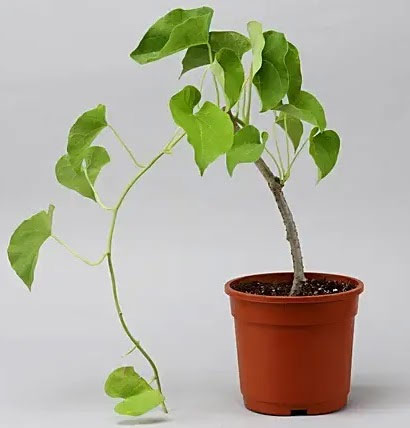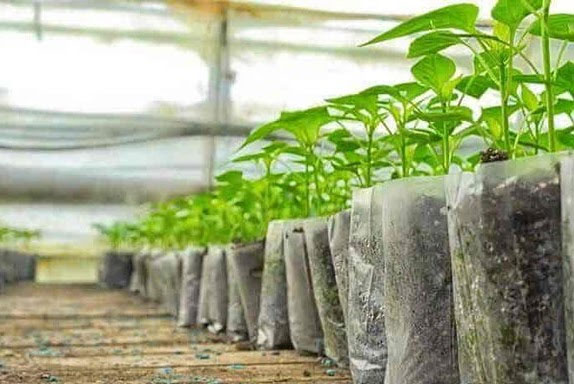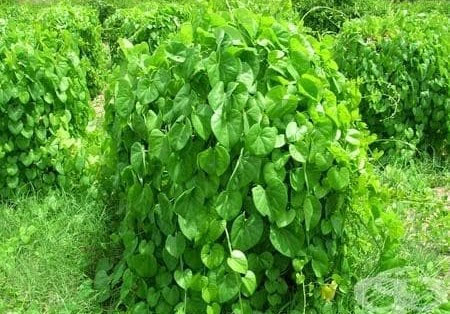Cultivation
Cultivation

Generally, Giloy is cultivated as ornamental and can be easily propagated by stem cutting. It grows well almost in any type of soil and under climatic conditions. The plant is generally grown on neem trees to get more medicinal value. This plant can also be grown by sowing seeds in the monsoon, but the growth of seedlings is very slow as compared to plants grown by cuttings.
Climate and soil
Subtropical and tropical climate is suitable for the cultivation of Giloy. Light-medium sandy loam soil rich in organic matter, and with adequate drainage, is suitable for its cultivation. It does not tolerate high rainfall or waterlogged conditions.
Propagation material
Stem cuttings are the best planting material for raising the commercial crop. The cuttings can be obtained from the mother plant in June-July. The plant can also be raised by using seeds, but growth will be slow in comparison to stem cutting.
Nursery techniques
Raising propagules: The stem cuttings are sown directly in the field. Cuttings are obtained from older stems with nodes. Cuttings should be sown within 2 hours of their removal from the mother plant. Meanwhile, they should be half-dipped in water vertically.
Propagule rate and pretreatment: About 2500 cuttings are required for plantation in one hectare of land. No specific treatment is required before sowing.

Agro-techniques

- The soil of the field will be treated with farmyard manure and nitrogen contained manure.
- An optimum distance (3m x 3m) should maintained between the plants during plantation.
- Being a twiner plant, it needs a host tree/plant to grow faster.
- Supply of farmyard manure along with nitrogen and removal of weed should be done regularly.
- Rainfed conditions are more favorable for the plant. But occasional irrigation is also required in extreme cold and hot conditions.
- Till now no serious insect, pest infestation or disease has been reported in this crop.
Admission - 2023 Live Video Counselling
To continue interaction with our expert admission counsellors enter the passcode 123456 for career guidance to discover the best suited programmes for you. Available from 10 am to 5 pm on all working days.
ICC
- The Sexual Harassment of Women at Workplace (Prevention, Prohibition and Redressal) Act, 2013
- UGC ( Prevention, Prohibition and Redressal of sexual harassment of Women employees and students in Higher Educational Institutions ) Regulations, 2015
- Handbook on Sexual Harassment of Women at Workplace issued by the Ministry of Women and Child Development, Government of India
- Internal Complaints Committee
- Sexual Harassment Complaint Registration: - icc@lpu.co.in
- Anti Sexual Harrasment Policy
Admissions for 2017-2018 are closed, except for the following
programmes.
Important Information - LPU Admissions 2020 Update.
Lovely Professional University is closely monitoring the ongoing COVID-19 pandemic. As the condition
continues to change rapidly, our top precedence remains the safety and well-being of our community.
We are planning for several contingency scenarios in order to restrict the physical contact with
individuals on campus and visitors from outside in order to support the mission of Indian government
to stop the potential transmission of the COVID-19.
To support prospective students (candidates) to apply for
admissions in different programmes by offering online/remote admission process during
the COVID-19 pandemic national lockdown period, the following arrangements have
been introduced:
For B.Tech. Admissions:
- Last date to apply has been extended from 31st March, 2020 to 20th April, 2020. Click here to apply
- LPUNEST Test Dates will be informed as and when Government announces JEE Mains schedule in order to provide candidates with clash free schedule. University is also evaluating the options to offer Online proctored LPUNEST remotely.
- Two Schedules of Counselling will be conducted (both online):
- Regular Schedule of Counselling – After the conduct of LPUNEST exam which is dependent upon Government decision on lockdown due to Covid-19.
- Special Schedule of Counseling – Before the conduct of LPUNEST exam, for all those candidates who already have JEE Mains or LPUNEST score (exams conducted in January 2020).
- Special Schedule of Counselling will be conducted online only as per the dates mentioned below:
| Result / Rank declaration | 22nd April, 2020 |
| Filling of Seat Preference (Online) | 22nd April, 2020 to 24th April, 2020 |
| Allotment letter (Online) | 25th April, 2020 |
| Fee Deposit & Admissions (Online) | 25th April, 2020 to 30th April, 2020 |
- This Special Schedule of counselling will help the students with existing score of JEE (Mains) or LPUNEST to confirm their admission and they need not to appear for LPUNEST exam again.
- Regular Schedule of counsellingmay be conducted only on the basis of LPUNEST exam and not on the basis of JEE (Mains) score so all candidates having JEE Mains (Jan Schedule) score are advised not to wait for Regular Schedule of counselling and try to confirm the admission through Special Schedule of counselling.
- Applicants who do not have LPUNEST score or JEE (Mains) score because they did not appear for exams in January / February shall apply on or before 20th April, 2020. The schedule of LPUNEST exam and counselling / admission process will be informed later.
- Candidates participating in Special Counselling schedule (as per Table mentioned above), if interested, may appear for LPUNEST to improve their score for Scholarship and/or participate in Regular Schedule of counselling again for changing / improving the allotted branch.
- The ranks declared in Special Counselling schedule will not be used for LPUNEST Study Grant.
For MBA Admissions:
- Last date to apply has been extended till 20th April, 2020. Click here to apply
- University has decided to conduct remote video Interviews for admission in MBA during the national lockdown period due to Covid-19. LPUNEST will now be conducted for scholarship only.
| Interview Scheduling | 8th April, 2020 – 20th April, 2020 |
| Interview Conduct | 10th April, 2020 - 23rd April, 2020 |
| Interview Result | 25th April, 2020 |
| Admission | 25th April, 2020 - 30th April, 2020 |
- Considering the current COVID-19 Pandemic situation, University has also decided to extend the Last date of MBA Admissions for January applicants till 30th April, 2020.
For All other Programmes:
Admissions are open for all other programmes in the online mode. LPUNEST will be conducted for scholarship only. Click here to proceed with admissionFor Ph.D. Programme:
- LPUNEST and subsequent interview will be conducted as per schedule communicated earlier.
- Slot booking for exam will be open from 15 April 2020 onwards. Click here to apply
Toll Free: 1800-102-4057
COVID-19
Dear Student,
The University has been closely monitoring the recent global developments regarding the threats
posed by COVID-19 also known as novel corona virus. It is putting in best possible efforts
towards adopting the necessary preventive measures as per the communications received from
Department of Health and Family Welfare and Ministry of Human Resources and Development (MHRD). In
alignment with the directives issued by the Punjab Government, all classes in the University
shall remain suspended till March 31st, 2020. However, during this period the University
shall transit from in-person teaching to online/remote academic connect.
In this regard the following guidelines should be adhered to by the students:-
- Students should download and install the “LPU Live” App for online/remote academic connect (the details in this regard have been updated on UMS). The students shall continue their studies through the “LPU Live” App and LPU-UMS.
- The University shall remain functional and faculty/staff shall be available during the working hours for all kinds of academic support required by the students.
- Incase students opt to undertake any personal domestic travel; it is advised that all necessary precautionary measures and hygiene advisories should be followed.
- International travel by the students is strongly discouraged.
- Students should avoid participation in large gatherings or venturing out to crowded places.
- All University events scheduled till March 31st, 2020 stand postponed till further notice.
- There shall be no changes in the Academic Calendar of the current term.
Notifications/ Events
ARIIA
- Email ID for Comments & Feedback : registrar@lpu.co.in
NIRF
- Report of NIRF Data Capturing System: Management
- Report of NIRF Data Capturing System: Pharmacy
- Report of NIRF Data Capturing System: Engineering
- Report of NIRF Data Capturing System: Overall
- Report of NIRF Data Capturing System: Law
- Report of NIRF Data Capturing System: Architecture
- Report of NIRF Data Capturing System: Agriculture
- Email ID for Comments & Feedback : registrar@lpu.co.in





 Whatsapp
Whatsapp